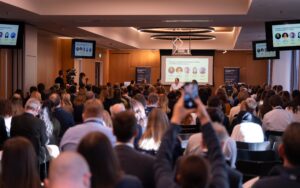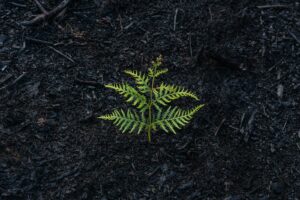Artificial intelligence (AI) is the latest weapon to be used in the battle to save the world’s endangered rainforests, Jamie Hailstone investigates.
Following various controversies involving exams and planning last year, the humble algorithm has become something of a dirty word in Britain.
But a new partnership between Hitachi Vantara, a division of the global technology firm Hitachi, and the charity Rainforest Connection has proved that algorithms can be a force for good, particularly when it comes to protecting the environment.
The two organisations have teamed up to create an early detection system, which uses a network of sensors that are placed at the top of trees across a rainforest. Using artificial intelligence to analyse the recordings, an algorithm is able to build a model of what the rainforest should normally sound like, called a bio-acoustic signature.
The system can then use this signature sound to spot any potential anomalies, and then warn rangers that somebody is in the rainforest and illegal logging might be occurring.
‘We’re putting AI to work for the planet,’ explains Hitachi Vantara’s global co-creation lead for IOT & analytics, Josh Siegel.
In terms of rainforest destruction, the World Wildlife Fund estimates that an area the size of an American football field is lost every two seconds.
Deforestation can cause the extinction of hundreds of animal and plant species every year, contributing to droughts, and threatening indigenous reserves across multiple continents. It also accounts for 10% of all worldwide carbon emissions, according to the Rainforest Alliance, making it a massive contributor to global warming, with up to 90% of deforestation attributed to illegal logging.
‘Rainforest Connection was founded in 2013 by Topher White,’ explains Mr Siegel. ‘His idea was to repurpose old mobile phones and hang them in the rainforest. The phones then would upload audio of the rain forest and use an algorithm that they developed to detect the sound of chainsaws. When alerted, the charity would then deploy local law enforcement to stop these illegal loggers.’
However, Rainforest Connection’s entire process to review and verify the files could take up to 14 days and, in some cases, trees are lost by the time rangers arrived on site.
‘Hitachi Vantara, which is the data and analytics arm of the global Hitachi Group, has a similar mission in that we have a corporate goal of what we call powering good and social innovation. I met Topher two years ago, and I resolved then to figure out how our technology could improve their results. We found a way to dramatically improve the deforestation prevention that they do, using our technology.’
At Hitachi’s conference, NEXT 2019, Hitachi Vantara announced the partnership and donated $250,000 in cash and in-kind services to Rainforest Connection to support its mission.
Using the company’s Lumada data analytics technology, Hitachi Vantara built algorithms that create a baseline of rainforest sounds.
This bio-acoustic signature then simplifies and accelerates the process of identifying acoustic anomalies. For example, before starting a chainsaw, loggers will typically scout appropriate locations in advance. Their presence causes a change in species’ acoustic signatures and signals a disruption to the environment. Hitachi Vantara’s solution detects these advance warnings and alerts rangers in real-time.
Rangers who use this technology get up to five days lead time to arrive on site. This head start gives rangers valuable time to pre-position themselves and prevent even more deforestation than they can today.
‘When something enters a rainforest that the animals don’t recognise, the bio-acoustic signature changes,’ adds Mr Siegel. ‘Species that are typically quiet sound alarm calls and some species that typically are vocal, go quiet. This is the first time, to my knowledge, that a bio–acoustic signature has been baselined, and we can now detect anomalies to that baseline. What that allows us to do is, is predict with 96% accuracy, up to five days in advance when the chainsaws are actually going to start.’
The system is now being used in Sumatra, where over 70% of all deforestation is illegal and the aim is to roll it out to the entire network of Rainforest Connection guardians, located in more than 11 countries this year.
‘The sounds of the forest are very different at dawn or dusk, versus the middle of the day,’ says Mr Siegel. ‘And all those elements are accounted for.
But we see wider applicability for this technology outside of a rain forest environment. Hitachi has a huge industrial footprint. We have 800 or so business units, many of which operate in the industrial space. Whereas acoustic monitoring of individual industrial components is fairly ubiquitous, we now have the ability for the first time, to create to monitor an ecosystem, and that ecosystem could be a rain forest, or it could be a factory floor.’
‘In this country, we’ve had issues with high tension wires causing wildfires out in California. You can envision a scenario with acoustic monitoring on high tension wires, listening for predictors of events that might cause a fire or that indicate a line has snapped, for example.’
‘We’re also thinking about ocean environments,’ he added. ‘We’ve had preliminary talks with entities who are interested in predicting the movement of ships and submarines, based on reactions or lack of reactions of wildlife in the oceans to those normal events.’
Similar technology has already been deployed here in the UK by many water companies, who now use acoustic microphones or loggers, as they are sometimes known, in pipes to listen for any signs of leakage, with software being used to analyse the recordings and spot warning signs.
Mr Siegel adds that although the system has only been up and running in Sumatra for a month, the initial feedback has been ‘very positive.’
‘We have been collaborating with Hitachi Vantara for the past year on tech development that is going to make it possible to know when there is a threat in the rainforest before the threat even begins,’ says Rainforest Connection’s Mr White.
This cutting-edge, game-changing innovation in machine learning model development will make it possible to better protect the world’s rainforests and other at-risk areas, with hundreds of thousands of acres of land and the survival of many species hanging in the balance.
‘The ecoacoustics baseline signature identification model enables us to know when there is a disturbance in the forest before the first tree is cut or animal is poached, making it possible for rangers to get to the site and take preventative actions. RFCx looks forward to expanding our partnership with Hitachi Vantara to implement this model to create real impact on the ground worldwide in 2021.’
The chief executive officer of Hitachi Vantara, Gajen Kandiah, adds: ‘The rainforest of Sumatra and Silicon Valley may be separated by thousands of miles, but data is the bridge between us, and has to be the foundation for solving some of our planet’s biggest challenges.’
‘At Hitachi, we believe in the power of data to benefit both business and society. We are immensely proud to partner with Rainforest Connection to make a meaningful difference in the fight against climate change.’
Mr Siegel says using AI to help save the rainforest has been the highlight of his career.
‘It’s a very special thing to be able to do,’ he tells Air Quality News.
‘And the partnership that Hitachi Vantara has with Rainforest Connection is only getting stronger. In 2021, we plan on deploying the enhanced solution, and expanding the partnership.’
‘AI or machine learning is so impactful across so many different aspects of society. We’ve shown it can be exponentially impactful in this scenario, and it will continue to be so.
I’ve spent a career focused on big data, data analytics and data science. I think applying that discipline to climate change, to the environment and social good is the next frontier. There’s a lot of opportunity there.’
This article first appeared in the February Air Quality News magazine, click here to view.















